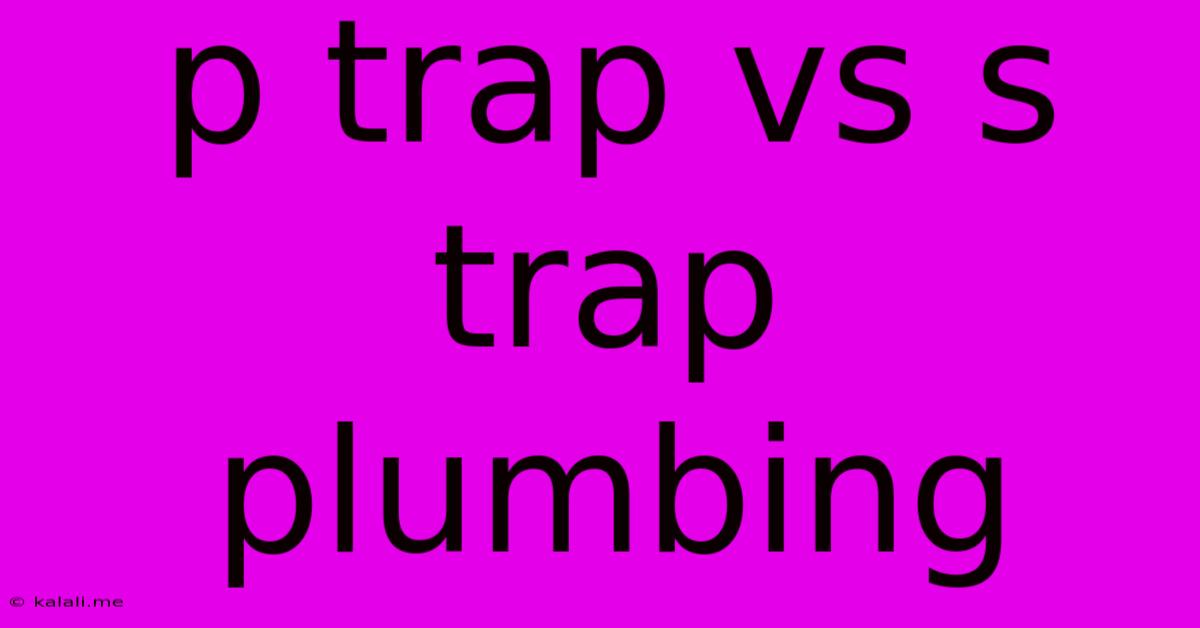P Trap Vs S Trap Plumbing
Kalali
May 22, 2025 · 3 min read

Table of Contents
P-Trap vs. S-Trap Plumbing: Which is Best for Your Home?
Choosing the right plumbing fixtures is crucial for a functional and efficient home plumbing system. While often overlooked, the type of trap used under your sinks and other plumbing fixtures plays a significant role in preventing sewer gases from entering your home. This article dives into the key differences between P-traps and S-traps, helping you make an informed decision for your home’s plumbing. We’ll cover their design, functionality, advantages, and disadvantages to illuminate the best choice for your needs.
Understanding P-Traps and S-Traps: A Visual Comparison
Both P-traps and S-traps are plumbing fixtures designed to prevent sewer gases and odors from entering your home. They achieve this by holding a small amount of water, creating a water seal that acts as a barrier. However, their designs differ significantly:
-
P-Trap: Named for its characteristic "P" shape, this trap features a curved pipe that holds water, creating the crucial seal. The design ensures a consistent water seal, even with infrequent use.
-
S-Trap: This trap, shaped like a backwards "S," is simpler in design. However, its design is less effective at maintaining a consistent water seal compared to the P-trap.
Key Differences: Functionality and Performance
The fundamental difference lies in their ability to maintain the water seal. Here's a breakdown:
P-Trap Advantages:
- Superior Water Seal: The P-trap's design ensures a more reliable and consistent water seal, even with low water flow. This minimizes the risk of sewer gases escaping.
- Less Prone to Siphoning: The design is less susceptible to siphoning, a condition where the water seal is drawn out, leaving your home vulnerable to sewer gases.
- Improved Odor Prevention: The superior water seal translates to better odor prevention, keeping your home fresh and clean.
S-Trap Disadvantages:
- Prone to Siphoning: The S-trap's design is more prone to siphoning, particularly with high water flow or infrequent use. This can lead to sewer gas intrusion.
- Weaker Water Seal: The shallower water seal is less effective at blocking sewer gases.
- Increased Odor Risk: Due to its weaker seal, it carries a higher risk of allowing sewer gases and odors to enter your home.
Modern Plumbing Practices and Code Compliance
While S-traps were once more common, modern plumbing codes often favor P-traps due to their superior performance and improved safety. The stronger water seal and reduced risk of siphoning make P-traps the preferred choice for most residential applications. Consult your local plumbing codes for specific requirements in your area.
Choosing the Right Trap for Your Needs
For most homeowners, the choice is clear: a P-trap offers superior performance, reliability, and better protection against sewer gases. While S-traps might seem simpler and potentially cheaper initially, the long-term benefits and improved hygiene of a P-trap far outweigh any minor initial cost difference. Investing in a well-designed and properly installed P-trap is a worthwhile investment in your home's health and comfort. Consider consulting a qualified plumber for any plumbing installation or repair work to ensure proper function and code compliance.
Latest Posts
Latest Posts
-
How To Drain A Hot Water Heater
May 22, 2025
-
Positive Definite And Positive Semidefinite Matrix
May 22, 2025
-
Arham City How To Get Phones To Ring
May 22, 2025
-
How To Find The Vertex Of A Rotates Parabola
May 22, 2025
-
Any Number Times Itself Is Always
May 22, 2025
Related Post
Thank you for visiting our website which covers about P Trap Vs S Trap Plumbing . We hope the information provided has been useful to you. Feel free to contact us if you have any questions or need further assistance. See you next time and don't miss to bookmark.